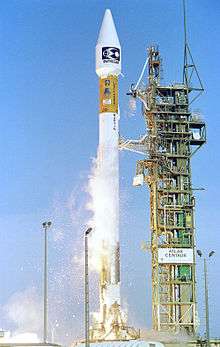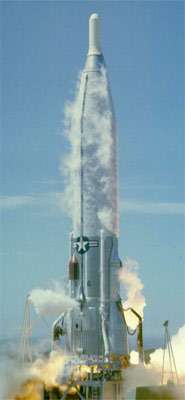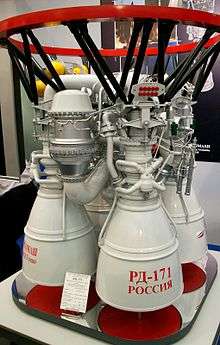Atlas III
The Atlas III (known as the Atlas II-AR (R for Russian) early in development[2]) was an American orbital launch vehicle, used between 2000 and 2005.[3] It was the first member of the Atlas family since the Atlas A to feature a "normal" staging method, compared to the previous Atlas family members, which were equipped with two jettisonable outboard engines on the first (booster) stage (with a single center engine serving as the sustainer).
 The maiden flight of the Atlas III | |
| Function | Medium expendable Launch vehicle |
|---|---|
| Manufacturer | Lockheed Martin |
| Country of origin | United States |
| Size | |
| Height | 52.8 m (173 ft) |
| Diameter | 3.05 m (10.0 ft) |
| Mass | 214,338 kg (472,534 lb) |
| Stages | 2 |
| Capacity | |
| Payload to LEO | IIIA: 8,640 kg (19,040 lb) IIIB: 10,218 kg (23,630 lb) |
| Payload to GTO | IIIA: 4,055 kg (8,939 lb) IIIB: 4,500 kg (9,900 lb) |
| Associated rockets | |
| Family | Atlas |
| Launch history | |
| Status | Retired |
| Launch sites | SLC-36B, CCAFS |
| Total launches | 6 (IIIA: 2, IIIB: 4) |
| Successes | 6 (IIIA: 2, IIIB: 4)[1] |
| First flight | IIIA: May 24, 2000 IIIB: February 21, 2002 |
| Last flight | IIIA: March 13, 2004 IIIB: February 3, 2005 |
| First stage | |
| Engines | 1 RD-180 |
| Thrust | 4,148.7 kN (932,700 lbf) |
| Specific impulse | 311 seconds (3.05 km/s) |
| Burn time | 132 seconds |
| Fuel | RP-1 / LOX |
| Second stage (Atlas IIIA) – Centaur (SEC) | |
| Engines | 1 RL-10A |
| Thrust | 99.2 kN (22,300 lbf) |
| Specific impulse | 451 seconds (4.42 km/s) |
| Burn time | 738 seconds |
| Fuel | LH2 / LOX |
| Second stage (Atlas IIIB) – Centaur (DEC) | |
| Engines | 2 RL-10A |
| Thrust | 147 kN (33,000 lbf) |
| Specific impulse | 449 seconds (4.40 km/s) |
| Burn time | 392 seconds |
| Fuel | LH2 / LOX |
Description
The Atlas III consisted of two stages. The first stage was new, but the upper stage was the Centaur, which is still in use today on the Atlas V EELV. The first stage engines were Russian RD-180s, which are also used by the Atlas V. The Atlas III was produced in two versions. The baseline was the Atlas IIIA, but the Atlas IIIB, featuring a twin-engine version of the Centaur upper stage, was also produced.[1]
Launches
The first flight of the Atlas III occurred on 24 May 2000, launching the Eutelsat W4 communications satellite into a geosynchronous orbit.[4] All Atlas III launches were made from Space Launch Complex 36B at Cape Canaveral Air Force Station. The Atlas III made its sixth and last flight on 3 February 2005, with a classified payload for the United States National Reconnaissance Office.[5][6]
GX
The GX rocket, formerly under development by Galaxy Express Corporation, was originally intended to use the boost stage of the Atlas III, provided by Lockheed-Martin, and a newly designed upper stage. It would have launched from the Tanegashima Space Center, south of Kyūshū, Japan. In December 2009 the Japanese government decided to cancel the GX project.[7]
See also
- Comparison of orbital launchers families
References
- Space Launch Report: Atlas III Data Sheet (accessed September 24, 2014)
- "Lockheed Martin Selects RD-180 to Power Atlas IIAR". International Launch Services. January 17, 1996. Retrieved March 9, 2013.
- "Atlas IIIA". Encyclopedia Astronautica. Archived from the original on July 1, 2013. Retrieved March 8, 2007.
- "Atlas-3A (Atlas-IIIA)". space.skyrocket.de. Retrieved June 6, 2020.
- Ray, Justin (February 3, 2015). "Last Atlas 3 rocket launches a pair of spy satellites". spaceflightnow.com. Retrieved June 6, 2020.
- KSC, Charlie Plain:. "NASA - Out With a Bang!". www.nasa.gov. Retrieved June 6, 2020.CS1 maint: extra punctuation (link)
- "Japan scraps GX rocket development project". iStockAnalyst. December 16, 2009. Archived from the original on March 6, 2014. Retrieved December 16, 2009.

